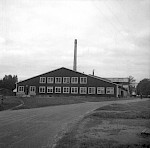Kosta got its name in 1742 from the founders themselves, Anders Koskull and Georg Bogislaus Stael von Holstein (two former officers from the Charles XII’s army), Ko-Sta and after a while the whole town came to be named after the growing glassworks. Window glass, bottles and tableware for the royal houses, chandeliers for churches and manors - this is what production looked like for the first 150 years. The first glassblowers were immigrant masters from German Bohemia. They mastered a professional knowledge that for generations was passed down from father to son.
As industrialisation increased construction and prosperity for more people, the demand for glass grew. During the second half of the 19th century, just over 100 years after Kosta birth, most of Sweden’s glassworks were founded. Many of them grew with the help of masters and glassblowers from Kosta. Until the end of the 19th century, the glassware in Kosta was designed by the workers themselves or by the customer.
At the Stockholm Exhibition in 1897, the creations were criticised for its uniformity, after which the idea of hiring designers in the production process was born. The first designer associated with Kosta was Gunnar Gunnarsson Wennerberg in 1898. Ever since then, a large number of designers such as Erik Höglund, Mona Morales-Schildt, and Bertil Vallien have enriched the company glass tradition.

